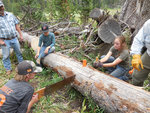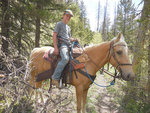Clear, 40° F
For more than a quarter century, Bruce Fauskee has been heading out into the wilderness on a mission. Clearing trails with the Shoshone Back Country Horsemen, Fauskee not only has seen much of what …
This item is available in full to subscribers.
The Powell Tribune has expanded its online content. To continue reading, you will need to either log in to your subscriber account, or purchase a subscription.
If you are a current print subscriber, you can set up a free web account by clicking here.
If you already have a web account, but need to reset it, you can do so by clicking here.
If you would like to purchase a subscription click here.
Please log in to continue |
|




For more than a quarter century, Bruce Fauskee has been heading out into the wilderness on a mission. Clearing trails with the Shoshone Back Country Horsemen, Fauskee not only has seen much of what makes the Absaroka Mountain Range unique, he has also helped make it easier for everyone to reach wilderness destinations just short of heaven.
But he hasn’t been alone.
Bruce first took his children to help with the chapter’s quests. Bryce and Bret learned many of the lessons community service has to offer while with their father. Now the perennial volunteer and patriarch has his grandchildren by his side with the hope that soon they will take over the critical work. Without the recruitment of “fresh blood,” many of northwest Wyoming’s trail systems would be close to impassable, Fauskee said. “They might not close, but it would be very hard to get around.”
Carter, 11, and Cole, 14, have accompanied their grandfather on several trips. “They can go, go, go all day long,” said Fauskee’s wife, Bonnie.
It’s not just a work detail, Bruce said. Young volunteers are learning horsemanship and fall in love with the mountains just like he did. Intimate details about trails, learned through the decades, are also being handed down to his progeny. It’s the perfect combination to make stewardship of the hundreds of miles of trails a natural conclusion while saving secrets that may have otherwise been lost.
Consider the numbers: The chapter cleared about 125 miles of trails in 2021, averaging about 20 trees cut and cleared per mile. In much of the range — anywhere designated as wilderness — handsaws are required due to regulations restricting the use of motors.
One of the few statistics not kept by the club are the number of blisters earned on the trail. If they kept count, Danika Fagan may have this year’s record. At 14, she worked with her father, chapter member Frank Fagan, on multiple trails through the summer putting in 314 miles in the saddle with the crews.
Danika has passed on what most youngsters consider cool and instead spends her time among the peaks. Despite having few kids her age around, the labor involved and having no cell signal for hours or days at a time, she’s always ready to load up the trailer before sunrise for time on her Tennessee Walker, Jet.
“I love it here,” she said while heading up Trail Creek to the top of the Lodgepole trailhead.
As the pair passed through an area of new growth after the 1988 fires, they stopped several times to clear yet another dead fall tree. While there were only a few to clear on this trip, evidence of the chapter’s work is abundant. Hundreds of trees have been cut and removed from the trail here over the past three decades. “We can have as many as 40 trees to cut per mile,” Frank said.
The rest of the Fagan family is involved in the chapter as well. Danika’s sister, Shelby, put in 78 miles in 2021, but has found a passion for the healthcare industry and works nearly full-time while attending Powell High School.
Recruiting young members is important to the sustainability of volunteer service organizations, but it isn’t easy. Trying to find ways to reach new generations of volunteers is a common struggle among many organizations nationwide.
Research has shown that, while over 90% of people want to volunteer, only one in four Americans actually do, reports Amy Yotopoulos with the Stanford Center on Longevity. She said there are three reasons so few people volunteer their time for community projects. The first: schedules and commitments are too inflexible.
That’s especially true for kids these days and, for the most part, their parents as well. Other barriers to volunteering include not having enough information about the project and not being asked to join the organizations.
“Potential for increasing volunteerism is high if we are able to address these common barriers,” Yotopoulos said. “By reducing these barriers, we can create a new social norm of volunteering throughout one’s life; where it is expected that everyone volunteers starting from school age and throughout old age.”
While many involved in the Shoshone Back Country Horsemen are retired, they are actively working to increase awareness in the younger generations. They offer riding and horsemanship lessons for children at annual spring events as well as programs for adults. They also recruit new members at local tack sale/swap meet events hosted by the organization. The next event is being planned for March.
Chapter president Kandy Christian said it’s also important to keep in mind that the group has a great deal of fun to go along with the work.
Yotopoulos said enjoyment is important to successful recruiting.
“Most people are motivated to volunteer by personal gratification and having a meaningful experience,” she said.
With the Shoshone Back County Horseman, fun rides and the annual rendezvous give members time for fun exploration of the trails they maintain.
“It’s a great time to see the care and love we put into these trails,” Christian said. She also points out every volunteer is free to set their own level of commitment, based on availability.
“Any help is highly appreciated,” she said.